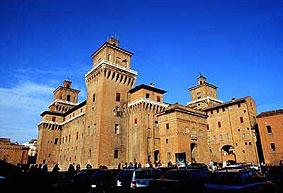


All the structures

Ferrara, a province in Emilia Romagna, is almost entirely flat. Its origin is shrouded in mystery, its name appearing for the first time in 753, in a document issued by the Lombard king Desiderius.
Ferrara opened the doors to culture in 1391 with the founding of its university.
Tiziano, Piero della Francesca and Leon Battista Alberti are just some of the great artists whose work and presence has embellished the city of Ferrara.
Ferrara’s Renaissance city centre is surrounded by nine kilometres of red city walls. The paths along the walls can be explored by bike or on foot, examining the collection of wild plant species exhibited in showcases.
The beautiful towers that rise above city are also a reddish colour. Places to visit are the Cathedral and the churches of S. Georgio, S. Paolo, S. Maria in Vado, the church of the Madonnina, del Gesù and S. Cristofero alla Certosa.
One of Ferrara’s most important exhibition centres is located in the Renaissance Palazzo dei Diamanti. The exhibition area on the ground floor holds interesting temporary exhibitions that traditionally focus on the cultural importance of the city. The Museum of Natural History can be visited in Via de Pisis. The city of Ferrara has many areas dedicated to nature: the Botanical Gardens, the Massari Park, the G. Bassani Park and the Pareschi Park. UNESCO has recognized Ferrara as a world heritage site.
The Ferrara Palio, considered to be the oldest palio in the world, takes place on the last Sunday of May in Piazza Ariostea.
Cento is a town to visit in the province of Ferrara. Cento is the birthplace of Guercino, an important Baroque painter. The main square in Cento, a town of porticos and ancient monuments, is named after him.
Cento offers lovers of good food excellent fresh pasta and pork. Cento is famous at a European level for its Carnival celebrations, also depicted in a fresco by Guercino.
Visit Codigoro, where the beauty of the Bishop’s Palace is striking. The Bishop's Palace is situated along the Riviera Cavallotti on the Po River. Once the seat of the Benedictine order, it is currently city property and houses the Municipal Library with more than twenty thousand books. A dramatic effect is created by the reflected image of this Venetian-style, architecturally beautiful building in the waters of the Po. Vigoleno is another of Italy’s architectural gems. Its castle rises among Ferrara’s woods and vineyards.